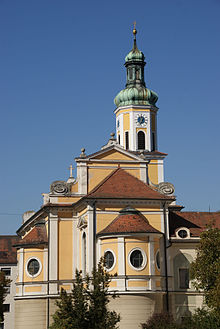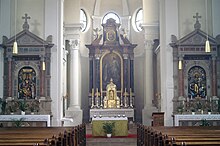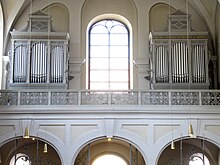St. Theresia (Regensburg)
St. Theresia is the former monastery church of the Discalced Carmelites and today's side church of the parish of St. Wolfgang, with the former monastery and seminar building on the corner of Kumpfmühler Strasse and Gutenbergstrasse in the Kumpfmühl district of Regensburg .
building
The neo-baroque church with a 45-meter-high steeple was built in 1900 according to plans by the Regensburg architect Philipp Krämer, on a plot of land acquired by the Carmelites in Kumpfmühl in 1851, based on the shape of the mother church of St. Josef , on the Alter Kornmarkt . To the east of the church is a building that was previously used as a boys' seminary until this facility was closed in 1975. The former monastery building stands north of the church and was used by the Carmelites until 1987. The church stands, characteristic of Carmelite churches, on a pedestal, which makes it appear elevated. The Vitusbach flows through the monastery property with the monastery pond.
history
On March 15, 1899, the population was informed about the planned construction on the front page of the Regensburg Gazette in an article along with a design drawing. Work on building the church began after the foundation stone was laid on August 26, 1899. The construction work was the responsibility of the builder Alois Janker. After his sudden death, Anton Mayer took over his job. After a construction period of only one year, which was short by the standards at the time, the church was built by Ignatius of Senestrey in honor of St. Teresa of Ávila inaugurated on August 27, 1900. In 1902 the clock tower and the organ were installed. The interior of the church was initially only whitewashed. In 1911 the church painter Johann Böckl was commissioned to carry out a rich painting in the neo-baroque style, which was completed in 1911. This was completely lost in the course of the war-related restoration from 1948, except for the ceiling fresco. In 1913 the high altar, made of Kufstein marble, was completed and in 1917 the Theresa picture was attached. The vestibule of the church was totally destroyed by bombs on December 28, 1944, and the west side of the church was badly damaged. The boys' college was a victim of the bombs after the air raid on April 16, 1945. The church was repaired in 1945, but the vestibule was no longer rebuilt. In 1949 the church was renovated to remove as much of the war damage as possible. This work could only be completed in 1956.
Furnishing
The so-called Infant Jesus of Prague is kept in a showcase . The high altar contains a high altar painting depicting Theresia von Avila by Martin von Feuerstein from 1931. The right side altar is a Joseph altar, the left a Carmel altar , on which Mary presents the scapular to the order general Johannes Soreth . Further altars are the Sacred Heart Altar and the Johannes Altar. The carved wooden pulpit is the work of the Stadtamhof sculptor Loibl. The three reliefs show the religious saints Cyril of Constantinople , John of the Cross and Angelus. The four ceiling paintings Christ Vision , Heart Wounding , Death of the Saints and Apotheosis are the work of Josef Weiniger from Regensburg from 1912. The entrance to the Carmelite crypt is in the center aisle, between the front pews.
organ
On the gallery, partially covered by a grille, stands an organ , built in 1902 by Binder and Siemann as Opus 119 with two manuals and 17 stops . After war damage, the organ was fitted with a new pneumatic console by Eduard Hirnschrodt and its sound was adapted to the taste of the time. In 1981 the organ was expanded to include two pedal stops . The disposition is:
|
|
|
||||||||||||||||||||||||||||||||||||||||||||||||||||||||||||||||||||||||||||
-
Pairing :
- Normal coupling: II / I, I / P, II / P
- Super octave coupling: II / I
- Sub-octave coupling: II / I
- Playing aids : one free combination , three fixed combinations, crescendo roller swell kick, tutti, three storage racks
- Remarks
- H = historical register
literature
- Alois Möstl and Hermann Reidl in: I saw an angel next to me St. Theresia Regensburg. Parish St. Wolfgang, Regensburg 2015. ISBN 978-3-9817126-1-2 .
- Peter Schmoll in: The Vitusbach Peter Morsbach, Regensburg 3/2014. ISBN 978-3-937527-75-8 .
- Parish of St. Wolfgang, Parish of St. Johannes, Advertising Association Kumpfmühl (Ed.): A district writes history. Regensburg-Kumpfmühl 79 1009 2009 . Regensburg 2008. ISBN 978-3-7917-2198-9 . Pages 333-337
- P. Paulinus in: Church and Monastery of St. Theresa in Regensburg-Kumpfmühl . Habbel, Regensburg 1912. Regensburg State Library, Sig .: 999 / Hab.208
Individual evidence
- ↑ Report in the Mittelbayerische Zeitung : The couple discovered the front page of 1899 in Stadel from November 11, 2015, vol. 71 No. 260 p. 34
- ↑ Regensburger Anzeiger No. 133 p. 1 of March 15, 1899. Habbel, Regensburg 1899. Regensburg State Library, Sig. 999 / Mif.3.
- ^ Peter Schmoll: Air raid. MZ Buchverlag Regensburg 1995, ISBN 3-927529-12-5 , p. 168
- ^ Christian Vorbeck: The organ builders Martin Binder and Willibald Siemann . Siebenquart Verlag Dr. Roland Eberlein, Cologne 2013, ISBN 978-3-941224-02-5 . → Print of the original work list
- ↑ After comparison with source, better version through recording on site by organ cleaners
Web links
Coordinates: 49 ° 0 ′ 30.4 ″ N , 12 ° 5 ′ 15 ″ E



